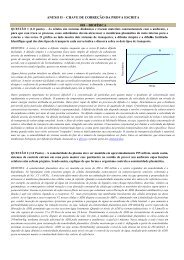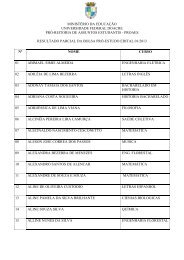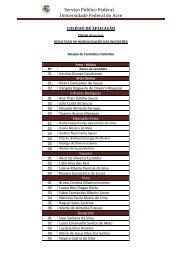Revista Brasileira de Ornitologia - Universidade Federal do Acre
Revista Brasileira de Ornitologia - Universidade Federal do Acre
Revista Brasileira de Ornitologia - Universidade Federal do Acre
Create successful ePaper yourself
Turn your PDF publications into a flip-book with our unique Google optimized e-Paper software.
Birds of the Brazilian state of <strong>Acre</strong>: diversity, zoogeography, and conservationEdson Guilherme401The vast majority of the 667 species recor<strong>de</strong>d for thestate – 602 (90,2%) – were classified as resi<strong>de</strong>nts, whereasfive (Bubulcus ibis, Geranoaetus albicaudatus, Caracaraplancus, Vanellus chilensis, and Athene cunicularia) wereconsi<strong>de</strong>red to be inva<strong>de</strong>rs, and another five as introducedspecies (Columba livia, Passer <strong>do</strong>mesticus, Sicalis flaveola,Sporophila maximiliani, and Estrilda astrild; Guilherme2000, 2011). The last species has adapted well to theregion (Silva 2004), and all introduced species nowreproduce in the wild in<strong>de</strong>pen<strong>de</strong>ntly.A total of 64 migratory species were i<strong>de</strong>ntified, ofwhich almost half 46.8% (n = 30) are Nearctic migrants,whereas 23.4% (n = 15) are consi<strong>de</strong>red to be intratropicalmigrants, and 29.6% (n = 19) austral migrants. Twospecies – Phoenicoparrus jamesi (Guilherme et al. 2005)and Heliomaster furcifer – were consi<strong>de</strong>red to be vagrants(Appendix 1).En<strong>de</strong>mic species<strong>Acre</strong> is located within the Inambari center ofen<strong>de</strong>mism (Haffer 1978; Cracraft 1985; Silva et al.2005b). Of the 57 taxa listed as en<strong>de</strong>mic to this centerby Cracraft (1985) and the 45 listed by Haffer (1978),41 were recor<strong>de</strong>d in <strong>Acre</strong> (Appendix 1). The speciesO<strong>do</strong>ntophorus stellatus, Phaethornis phillipii, Pteroglossusbeauharnaesii, Simoxenops ucayalae, Hemitriccusflammulatus, and Ramphotrigon fuscicauda are not listedas en<strong>de</strong>mic in Appendix 1 because subsequent studies (see<strong>de</strong>l Hoyo 1994, 1999, 2002, 2003, 2004; Perlo 2009)have exten<strong>de</strong>d their known ranges beyond the limits ofthe Inambari center. However, four species were ad<strong>de</strong>dto this list, including three more recently <strong>de</strong>scribed taxa(Nannopsittaca dachilleae, Thamnophilus divisorius andCnipo<strong>de</strong>ctes superrufus) and one (Hypocnemis subflava) thathas been raised to full species status. Therefore, currently41 Inambari en<strong>de</strong>mic species are known to occur in <strong>Acre</strong>(Appendix 1).Endangered speciesNone of the native species recor<strong>de</strong>d in the presentstudy is inclu<strong>de</strong>d in the Brazilian list of bird speciesthreatened with extinction (Macha<strong>do</strong> et al. 2008). Onthe other hand, Sporophila maximiliani, which wasintroduced into the state by bird fanciers, and is nowfound naturally in the wild, is the only species listedas endangered by Macha<strong>do</strong> et al. (2008). However, theIUCN (International Union for Conservation of Nature)red list inclu<strong>de</strong>s 10 species resi<strong>de</strong>nt in <strong>Acre</strong> in the nearthreatened (NT) category – Harpia harpyja, Morphnusguianensis, Primolius couloni, Nannopsittaca dachilleae,Formicarius rufifrons, Grallaria elu<strong>de</strong>ns, Synallaxis cherriei,Simoxenops ucayalae, Conothraupis speculigera, and Cacicuskoepckeae.HabitatsMost (77.8%) of the bird species recor<strong>de</strong>d in <strong>Acre</strong>are found in the <strong>de</strong>nse or open terra firme rainforest, withpalms and/or bamboo (Appendix 1). With the exceptionof a small proportion of species that are restricted tobamboo forest (Appendix 1), all other forest speciesrecor<strong>de</strong>d in <strong>Acre</strong> are associated with forests where palmsare present. Approximately 12.9% of the recor<strong>de</strong>d speciesare associated with aquatic environments, such as várzeaswamp forest, riverbank habitats, creeks, reservoirs, lakes,and the sandy beaches formed by mean<strong>de</strong>ring riversduring the dry season (Appendix 1).A small, but nevertheless important, proportion ofthe species (2.1%) is strictly associated with the vegetationthat grows on sandy soils, that is, the campinas andcampinaranas (Appendix 1). These habitats are located onlyin the extreme west of the state. Of all bird species associatedwith this type of habitat in <strong>Acre</strong>, at least nine (Patagioenasspeciosa, Polytmus theresiae, Dendrocolaptes certhiapolyzonus, Formicivora grisea, Schiffornis amazona, Neopipocinamomea, Xenopipo atronitens, Cnemotriccus fuscatusduidae, and Tachyphonus phoenicius) can be consi<strong>de</strong>redto be restricted to these habitats, and at least a furthertwelve (Crypturellus strigulosus, Topaza pyra, Fre<strong>de</strong>rickenaunduligera, Heterocercus linteatus, Machaeropterus striolatus,Manacus manacus, Hemitriccus minimus, Hemitriccusgriseipectus, Lophotriccus vitiosus, Poecilotriccus latirostris,Ramphotrigon ruficauda, and Attila citriniventris) arepartially restricted to them (Guilherme 2009, Guilherme& Borges, 2011, Guilherme & Aleixo, unpubl. data).Distribution patternsThe majority (79%) of the 667 species of birds foundin <strong>Acre</strong> occur in both of its sub-regions (separated by thePurus River), and hence throughout the state (Appendix1). A further 16% were recor<strong>de</strong>d only in the centralwesternsub-region of the state (west of the Purus), and5% only in its eastern portion (east of the Purus). Noneof the species are restricted to the central portion of thestate - the intermediate region between the Juruá andPurus rivers.At least five pairs of purported sister taxa werei<strong>de</strong>ntified with a distribution pattern consistent withclassic allopatry (Table 1). In all these cases, one or otherof each pair of taxa was found in different areas of thestate, e.g., Crypturellus undulatus undulatus/yapura andLepi<strong>do</strong>thrix coronata coronata/exquisita.A total of 15 sets of parapatric purported sistertaxa were i<strong>de</strong>ntified during this study, encompassing30 taxa, 26 of which are currently treated as subspecies(Table 2). In most cases, one of the parapatric taxa iswi<strong>de</strong>ly distributed in <strong>Acre</strong>, whereas the other has a morerestricted range (Table 2, Figure 5).<strong>Revista</strong> <strong>Brasileira</strong> <strong>de</strong> <strong>Ornitologia</strong>, 20(4), 2012










